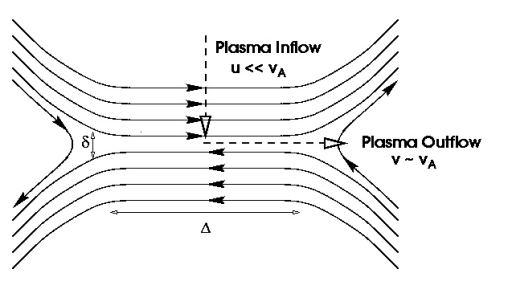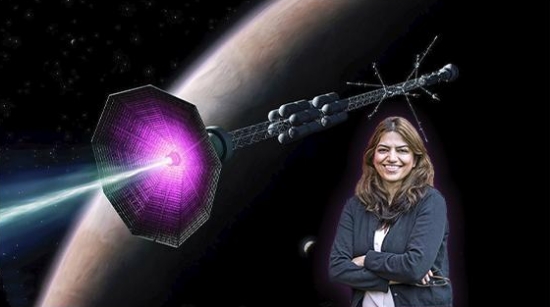At the Princeton Plasma Physics Laboratory (PPPL) in Plainsboro, New Jersey, physicist Fatima Ebrahimi has been exploring a plasma thruster that, on paper at least, appears to offer significant advantages over the kind of ion thruster engines now widely used in space missions. As opposed to electric propulsion methods, which draw a current of ions from a plasma source and accelerate it using high voltage grids, a plasma thruster generates currents and potentials within the plasma itself, thus harnessing magnetic fields to accelerate the plasma ions.
What Ebrahimi has in mind is to use magnetic reconnection, a process observed on the surface of the Sun (and also occurring in fusion tokamaks), to accelerate the particles to high speeds. The physicist found inspiration for the idea in PPPL’s ongoing work in fusion. Says Ebrahimi:
“I’ve been cooking this concept for a while. I had the idea in 2017 while sitting on a deck and thinking about the similarities between a car’s exhaust and the high-velocity exhaust particles created by PPPL’s National Spherical Torus Experiment (NSTX). During its operation, this tokamak produces magnetic bubbles called plasmoids that move at around 20 kilometers per second, which seemed to me a lot like thrust.”
In magnetic reconnection, magnetic field lines converge, separate, and join together again, producing energy that Ebrahimi believes can be applied to a thruster. Whereas ion thrusters propelling plasma particles via electric fields can produce a useful but low specific impulse, the magnetic reconnection thruster concept can, in theory, generate exhausts with velocities of hundreds of kilometers per second, roughly ten times the capability of conventional thrusters.

Image: Magnetic reconnection refers to the breaking and reconnecting of oppositely directed magnetic field lines in a plasma. In the process, magnetic field energy is converted to plasma kinetic and thermal energy. Credit: Magnetic Reconnection Experiment.
Writing up the concept in the Journal of Plasma Physics, Ebrahimi notes that this thruster design allows thrust to be regulated through changing the strength of the magnetic fields. The physicist describes it as turning a knob to fine-tune the velocity by the application of more electromagnets and magnetic fields. In addition, the new thruster ejects both plasma particles and plasmoids, the latter a component of power no other thruster can use.
If we could build a magnetic reconnection thruster like this, it would allow flexibility in the plasma chosen for a specific mission, with the more conventional xenon used in ion thrusters giving way to a range of lighter gases. Ebrahimi’s 2017 work showed how magnetic reconnection could be triggered by the motion of particles and magnetic fields within a plasma, with the accompanying production of plasmoids. Her ongoing fusion research investigates the use of reconnection to both create and confine the plasma that fuels the reaction without the need for a large central magnet.

Image: PPPL physicist Fatima Ebrahimi in front of an artist’s conception of a fusion rocket. Credit: Elle Starkman, PPPL Office of Communications, and ITER.
Thus research into plasmoids and magnetic reconnection filters down from the investigation of fusion into an as yet untested concept for propulsion. It’s important to emphasize that we are, to say the least, in the early stages of exploring the new propulsion concept. “This work was inspired by past fusion work and this is the first time that plasmoids and reconnection have been proposed for space propulsion,” adds Ebrahimi. “The next step is building a prototype.”
The paper is Ebrahimi, “An Alfvenic reconnecting plasmoid thruster,” Journal of Plasma Physics Vol. 86, Issue 6 (21 December 2020). Abstract.



I love the idea of magnetic reconnection and accelerated plasma particles and plasmoids, a brilliant idea. I think physicists should build a working model in the laboratory. I can imagine seeing these plasmoids flying out of it? Plasma physics is the future of efficient space propulsion. There won’t be a problem with making a small magnet for a magnetic field because the powerful magnets of the future will be much smaller. A table top MRI can be made with a new form a matter called a Fermion condensate. https://www.nasa.gov/audience/forstudents/postsecondary/features/12feb_fermi_prt.htm
The issue for me (as always) is how stable will be a fusion magnetic re-connection flux line system? I’m sure this is an area of active research and that it can be promising – but I wonder how promising it might be with regards to interplanetary propulsion.
The main reason I say all this is that while magnetic reconnection flux lines can be possibly tolerated in a fusion power plant which is typically a large plasma volume system and can (presumably to some degree) stand some perturbation in magnetic field lines, that may not necessarily be true in a smaller fusion system. Your depending upon controllability behind these magnetic re-connections to accelerate and provide thrust from this power source. Is it reasonable to be assured that this can be tamed to a sufficient extent to exploit it ?
The paper.
The wave (Wikipedia)
A video for the wave. Link from Wikipedia article. Will play in VLC player, free for iPadOS and IOS.
Seems promising.
Ah, But the secret ingredient is merging flux tubes…….
Relativistic resistive magnetohydrodynamic reconnection and plasmoid formation in merging flux tubes.
https://arxiv.org/abs/1810.10116
Told you. ;-}
While the high Isp is interesting, this does not miraculously change much. Electric engines typically scale power with exhaust velocity which reduces thrust-to-power ratios.
For example:
thrust/Power for some ION thrusters mN/KW
NSTAR 40
NEXT 81
Plasma thrusters mN/KW
VASIMR 25
Alfvenic reconnecting plasmoid thruster 5-10
The high specific impulse of the Alfvenic reconnecting plasmoid thruster comes at a cost – lower thrust per power input, as expected. The high thrust of VASIMR requires megawatts of power, usually assumed to be from a nuclear reactor. The Alfvenic thruster suggests a 10 MW power source.
It should be obvious that while propellant mass can be reduced with high Isp, the electrical energy to achieve this requires an increasing mass of reactor to supply it. At this point, solar power arrays have no better specific power than nuclear reactors and are unsuited to outer system use. Beaming power with lasers might be a future option, but is as yet untested, and would need multiples of the needed power to allow for low laser efficiency and other losses.
A breakthrough would be to have a net energy generation of fusion to supply the needed power once ignition was achieved. This would then just require a “battery” to start the reaction which the net energy generated would sustain the rocket, allowing the ship to discard the fission reactor.
Then we would start down teh road to have Heinlein’s “torch ships” or the “Epstein fusion drives” in The Expanse.
Just wondering if we could spin up the ends to tighten the fields more, magnetic reconnection as see in the sun is very powerful.
Interesting idea. My initial reaction was that propulaion via mag reconnection will however require very high power input. The thrust to power ratio is low. Only a fraction that of xenon thrusters.
From the paper
“In our simulations, Iinj is about 100 kA (equivalent to B? ? 500G), corresponding to about 10 MW of power. For this unoptimized high-power case (with a trust of 50-100N), the ratio of thrust over power is thus about 5-10 mN/kW. We have not yet performed a systematic optimization, but tentatively the optimal parameter range for this new thruster will be ISP (specific impulse) from 2,000 to 50,000 s, power from 0.1 to 10 MW and thrust from 1 to 100 Newtons. It would thus occupy a complementary part of parameter space with little overlap with existing thrusters.”
Current and experimental ion thrusters have thrust to power ratios of 20-50 mN/kW.
The high ISP is compelling but the power demands mean extra mass.
I still think we should experiment with as much as possible with ideas about fusion and magnetic confinement. Sometimes new ideas can have unexpected uses other than what they are intended like more efficient fusion reactions or plasma particle collisions as well as expulsions.
Specific impulse , ISP is inversely proportionate to fuel/reaction mass use . Measured in seconds. Space based miles per gallon if you will. Ion thrusters are hugely more efficient than their chemical powered cousins . with ISPs for some of the hypothetical plasmahydrodynamic variants in the tens of thousands . Even VASIMR can hypothetically reach around ten thousand seconds . By wayof comparison the Merlin vacuum full thrust engine has an ISP of 248 seconds with even the most efficient cryogenic rockets just exceeding a few hundred seconds. Thrust , as touched on here is power applied . This is indeed low for most ion thrusters . Though again some of the theorised plasmahydrodynamic engines can produce performance approaching the traditionally much higher figures of chemical rockets . Combined with their very high ISPs thismakes them very promising for transporting large masses over large distances in much shorter transit times – with trips to Mars being the obvious example. But as described at the cost of much higher power input- shading into Mega watts and dictating nuclear reactors as the only viable electrical supply and even then way beyond anything even in early development . At kilo watt level for the sort of compact unit capable of being integrated into a spacecraft .
In case anyone is not familiar with Atomic Rockets website, here is a link:
http://www.projectrho.com/public_html/rocket/
The content is vast addressing every imaginable propulsion technology, spacecraft design, war fighting in space and human factors. The material is technical but the math is basic. The writing is interesting and entertaining and comes across as credible. The original purpose of the site was to help aspiring SiFi writers avoid making bonehead mistakes in science and engineering. There is no bigger turnoff in SiFi than when the story gets the fundamentals wrong.
In multiple star systems, such as the senary star system described in a recent article, does magnetic reconnection of field lines from two or more stars happen near planets and asteroids? If so, how would that affect them?
Perhaps connecting the craft to the magnetic field could impart
increasing velocity, maybe multiple passes, much more??
Plasma Thruster Could Dramatically Cut Down Flight Times to the Outer Solar System.
“Ebrahimi’s plasma thruster creates similar magnetic reconnections we see in the Sun’s corona. Rather than a steady stream of accelerated particles like an ion engine, think of this design like mini CMEs going off every few milliseconds creating individual bubbles of plasma called “plasmoids.” These plasmoids are exhausted to create thrust. A simulated Ebrahimi engine reached specific impulse of 50,000 seconds with exhaust speeds of up to 500km/s! Much higher efficiency than current ion engine designs. The force generated is also much higher than ion thrusters – up to 100 Newtons.
Another huge advantage of the plasma thruster – it can run on almost any gas. Ion engines like the Hall Thruster launch with a limited supply of gas like Xenon which is ionized to create thrust. The plasma thruster’s magnetic reconnection process is more important to the total thrust than the type or mass of the gas used to generate plasmoids. So, your spacecraft could literally refuel out in space using gases found in rocks and asteroids and then continue on its journey.”
The naysayers need to take a closer look…
The force generated is also much higher than ion thrusters – up to 100 Newtons.
Need I say more?
https://www.universetoday.com/150066/plasma-thruster-could-dramatically-cut-down-flight-times-to-the-outer-solar-system/amp/